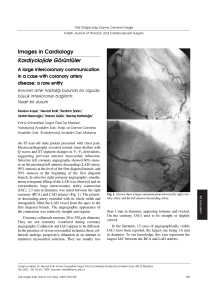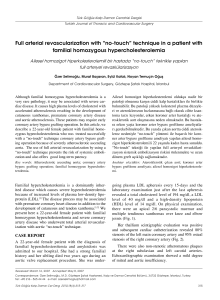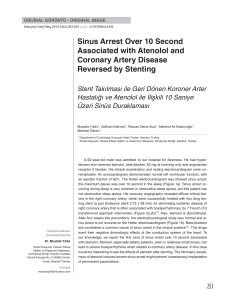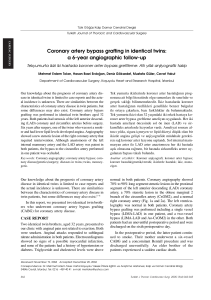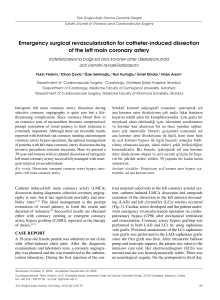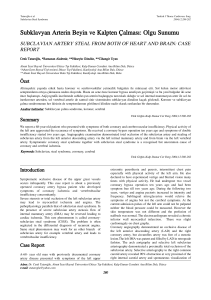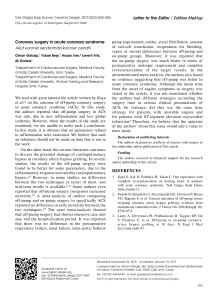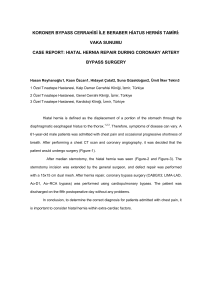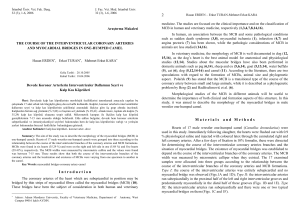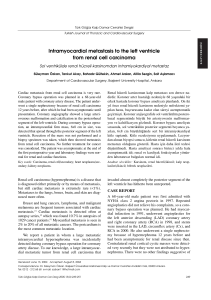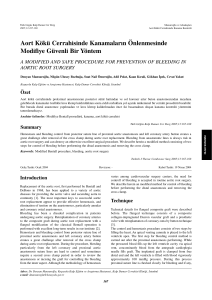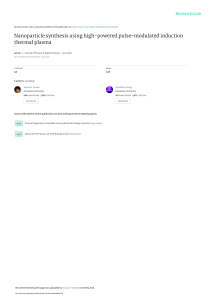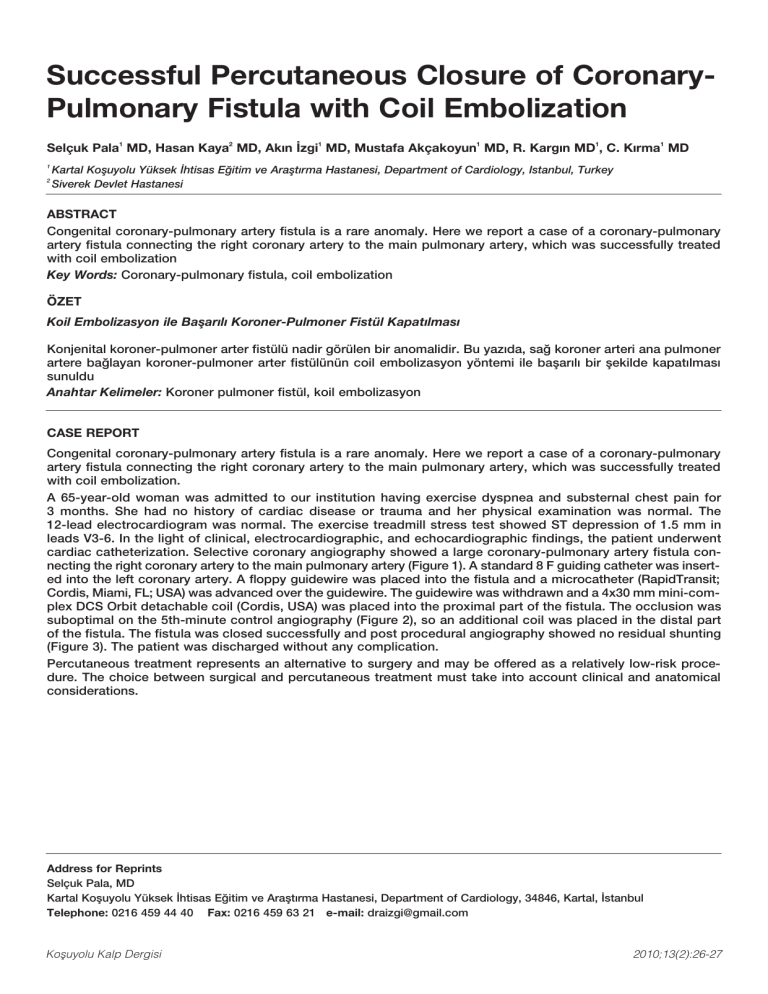
Successful Percutaneous Closure of CoronaryPulmonary Fistula with Coil Embolization
Selçuk Pala1 MD, Hasan Kaya2 MD, Ak›n ‹zgi1 MD, Mustafa Akçakoyun1 MD, R. Karg›n MD1, C. K›rma1 MD
1
2
Kartal Kofluyolu Yüksek ‹htisas E¤itim ve Araflt›rma Hastanesi, Department of Cardiology, Istanbul, Turkey
Siverek Devlet Hastanesi
ABSTRACT
Congenital coronary-pulmonary artery fistula is a rare anomaly. Here we report a case of a coronary-pulmonary
artery fistula connecting the right coronary artery to the main pulmonary artery, which was successfully treated
with coil embolization
Key Words: Coronary-pulmonary fistula, coil embolization
ÖZET
Koil Embolizasyon ile Baflar›l› Koroner-Pulmoner Fistül Kapat›lmas›
Konjenital koroner-pulmoner arter fistülü nadir görülen bir anomalidir. Bu yaz›da, sa¤ koroner arteri ana pulmoner
artere ba¤layan koroner-pulmoner arter fistülünün coil embolizasyon yöntemi ile baflar›l› bir flekilde kapat›lmas›
sunuldu
Anahtar Kelimeler: Koroner pulmoner fistül, koil embolizasyon
CASE REPORT
Congenital coronary-pulmonary artery fistula is a rare anomaly. Here we report a case of a coronary-pulmonary
artery fistula connecting the right coronary artery to the main pulmonary artery, which was successfully treated
with coil embolization.
A 65-year-old woman was admitted to our institution having exercise dyspnea and substernal chest pain for
3 months. She had no history of cardiac disease or trauma and her physical examination was normal. The
12-lead electrocardiogram was normal. The exercise treadmill stress test showed ST depression of 1.5 mm in
leads V3-6. In the light of clinical, electrocardiographic, and echocardiographic findings, the patient underwent
cardiac catheterization. Selective coronary angiography showed a large coronary-pulmonary artery fistula connecting the right coronary artery to the main pulmonary artery (Figure 1). A standard 8 F guiding catheter was inserted into the left coronary artery. A floppy guidewire was placed into the fistula and a microcatheter (RapidTransit;
Cordis, Miami, FL; USA) was advanced over the guidewire. The guidewire was withdrawn and a 4x30 mm mini-complex DCS Orbit detachable coil (Cordis, USA) was placed into the proximal part of the fistula. The occlusion was
suboptimal on the 5th-minute control angiography (Figure 2), so an additional coil was placed in the distal part
of the fistula. The fistula was closed successfully and post procedural angiography showed no residual shunting
(Figure 3). The patient was discharged without any complication.
Percutaneous treatment represents an alternative to surgery and may be offered as a relatively low-risk procedure. The choice between surgical and percutaneous treatment must take into account clinical and anatomical
considerations.
Address for Reprints
Selçuk Pala, MD
Kartal Kofluyolu Yüksek ‹htisas E¤itim ve Araflt›rma Hastanesi, Department of Cardiology, 34846, Kartal, ‹stanbul
Telephone: 0216 459 44 40 Fax: 0216 459 63 21 e-mail: [email protected]
Kofluyolu Kalp Dergisi
2010;13(2):26-27
Figure 1: Coronary angiography demonstrates a large coronary arteriovenous fistula (arrows) originating from the proximal right coronary
artery (RCA) and draining into the main pulmonary artery (PA).
Figure 3: Following the second coil (arrow) embolization to the
proximal part, the fistula completely disappeared.
Figure 2: The same angiographic view showing incomplete occlu-
sion of the fistula after coil (arrow) placement to the proximal part.
Kofluyolu Kalp Dergisi
Successful Percutaneous Closure of Coronary-Pulmonary ... 27

